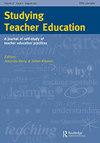Self-study as a Means of Understanding ‘Who I Am in How I Teach’
IF 1.5
Q2 EDUCATION & EDUCATIONAL RESEARCH
引用次数: 1
Abstract
The title of this editorial reflects one of the fundamental characteristics of self-study, that is, understanding the person within the professional and how the ‘who’ of the teacher educator is understood and enacted through practice. Understanding self and identity and its relationship with practice is captured in the title of Geert Kelchtermans’s (2009) seminal article, ‘Who I am in how I teach is the message’. Each of the five articles in this issue engages with issues of self and identity, albeit through different perspectives and via different means. The articles offer insights into the challenges experienced by teacher educators in choosing to investigate ‘who they are’ as they seek to establish their identities and (re)define their roles. The first article describes a collaborative self-study examining teacher educators’ understandings of self and practice, employing a novel approach to data collection and analysis. In their article, ‘Letting the Light In: A Collaborative Self-Study of Practicum Mentoring’, Awneet Sivia, Sheryl MacMath and Vandy Britton (Canada) investigate their identities as mentors, teacher educators and colleagues as they introduce a practicum innovation into their teacher education program. In order to honor the diverse and collaborative nature of their data, these authors employed the methodological tool of braiding that enabled them to create a more complex and complete representation of their experiences and insights. The authors propose the use of metaphorical tools such as braiding that can allow for different voices and data sets to be more equitably valued in self-study research. The next two articles continue the theme of examining personal and professional identity growth through collaborative self-study, although each begins from a different place in the life course. In their article, ‘It’s Definitely Something You Have to Work Towards: A First-year Female Faculty Member’s Attempt at Role Management’, Kelsey McEntyre, Victoria Shiver and Kevin Andrew Richards (USA) employed an adaptation perspective on role theory to investigate how Kelsey navigated her work and non-work roles as a new faculty member, wife and first-time mother. Role theory adopts a theatre metaphor to explain how individuals are expected to act based on the roles they play in society. Their study affirmed the importance of feeling comfortable to be vulnerable within a critical friendship, thereby enhancing the self-study process by allowing indepth conversations to occur. Following this article, Amon Glasser (Israel) examined the shaping of his academic identity through drawing on childhood episodes of formal and non-formal learning in his article, ‘Autoethnography of Childhood Memories: Clarifying and Enhancing Auto-Pedagogical Identity’. Together with two critical friends, he sought to understand how his early life episodes have served as shaping influences on his pedagogical beliefs, principles and practices as a teacher educator. Utilising autoethnography as a methodological approach, Glasser identified two main principles guiding his current approach: curiosity to learn and a humanistic approach. STUDYING TEACHER EDUCATION 2022, VOL. 18, NO. 2, 119–120 https://doi.org/10.1080/17425964.2022.2102930自学是理解“我是谁,我如何教学”的一种手段
这篇社论的标题反映了自学的一个基本特征,即理解专业中的人,以及如何通过实践理解和制定教师教育者的“谁”。Geert Kelchtermans(2009)的开创性文章《我是谁,我如何教学就是信息》的标题抓住了理解自我和身份及其与实践的关系。本期五篇文章中的每一篇都涉及自我和身份问题,尽管从不同的角度和方式进行探讨。这些文章提供了对教师教育工作者在选择调查“他们是谁”时所经历的挑战的见解,因为他们试图建立自己的身份和(重新)定义自己的角色。第一篇文章描述了一项合作自学研究,该研究考察了教师教育者对自我和实践的理解,采用了一种新颖的数据收集和分析方法。为了尊重他们的数据的多样性和协作性,这些作者采用了编织的方法工具,使他们能够创建一个更复杂和完整的代表他们的经验和见解。作者建议使用隐喻工具,如编织,可以让不同的声音和数据集在自学研究中得到更公平的评价。接下来的两篇文章将继续探讨通过协作式自学来检验个人和职业身份成长的主题,尽管每一篇文章的起点都不同。Kelsey McEntyre、Victoria Shiver和Kevin Andrew Richards(美国)在他们的文章《这绝对是你必须努力的事情:一名一年级女教员的角色管理尝试》中,运用角色理论的适应视角来研究Kelsey作为一名新教员、妻子和第一次做母亲是如何处理工作和非工作角色的。角色理论采用戏剧隐喻来解释个人如何根据他们在社会中扮演的角色行事。他们的研究肯定了在一段关键的友谊中感到舒适的重要性,从而通过允许深入的对话来加强自我学习的过程。在这篇文章之后,阿蒙·格拉瑟(以色列)在他的文章《童年记忆的自我民族志:澄清和加强自我教育身份》中,通过描绘童年时期的正式和非正式学习,研究了他的学术身份的形成。他和两个挑剔的朋友一起,试图理解他早年的生活经历是如何对他作为一名教师的教育信念、原则和实践产生影响的。利用自我民族志作为方法论,格拉瑟确定了指导他目前研究方法的两个主要原则:求知欲和人文主义方法。《教师教育研究2022》第18卷第1期。2,119 - 120 https://doi.org/10.1080/17425964.2022.2102930
本文章由计算机程序翻译,如有差异,请以英文原文为准。
求助全文
约1分钟内获得全文
求助全文
来源期刊

Studying Teacher Education
EDUCATION & EDUCATIONAL RESEARCH-
CiteScore
2.40
自引率
43.80%
发文量
23
期刊介绍:
Studying Teacher Education invites submissions from authors who have a strong interest in improving the quality of teaching generally and of teacher education in particular. The central purpose of the journal is to disseminate high-quality research and dialogue in self-study of teacher education practices. Thus the journal is primarily a forum for teacher educators who work in contexts and programs of teacher education.
 求助内容:
求助内容: 应助结果提醒方式:
应助结果提醒方式:


